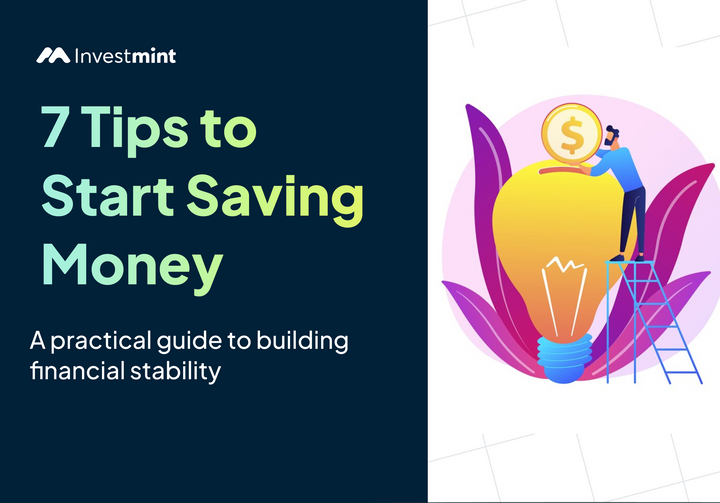5 Ways To Protect Your Investments From A Market Crash
We faced an uncertain year with IT layoffs, rising interest rates and war. Learn to protect your investments in a market crash with this read.

Introduction
The world currently fears recession, inflation, and whatnot. And it's natural for all of you to worry about your investments. A recession might bring in a wave of unemployment, leading to a drop in demand in almost all sectors and a drop in liquidity in the stock market. What follows is a determined decline/crash of the market.
Although the world will be affected by recessions, India is determined to be less affected. We have listed some reasons below with which you can protect your investments, so we are all cautious like every investor should be.
What is a Market Crash?
The stock market is often unpredictable, and it is not uncommon for investors to experience a market crash. A market crash refers to a sudden and significant drop in the value of securities traded in the financial markets. It usually results in a rapid decline of the stock market, with prices plummeting rapidly.
Some examples of market crashes are the Dotcom Crash in the 2000s and the subprime crisis in 2008.
Therefore, protecting your investments from a market crash is crucial, especially if you are approaching retirement, have an emerging expense like education/marriage/house loan, etc, or rely on your investments for income.
Global Recession 2023: Should you be worried?
The aftereffects of the COVID-19 waves and the forced liquidity in the market from the 2020s are finally coming to light. Combined with the ongoing war between Ukraine and Russia, it is causing many countries, even the developed ones, into recessions.
The Work from Home culture of the 2020s promoted the rapid use of software, which also led to immediate hiring for resources in those fields. However, with the world slowly returning to the pre-COVID normal and AI's rising capabilities, the demand for the IT sector is definitely shortened. Again, this promotes mass layoffs from IT companies, which has contributed to the drop in quarterly revenues and led to a decline in the market value of India-based IT service companies.
All these factors may be a catalyst in creating fear among investors. However, according to Bloomberg, India will be shielded from recessions. According to the report, there is a 0% chance for India to hit a slump while expecting a positive 5.9% change to the GDP of India.
How To Protect Yourself From Market Crash?
Below are some basic yet essential factors in designing and safeguarding your investments from unforeseen events.
1. Diversification:
Diversification is one of the best ways to protect your investments from a market crash. Diversification means spreading your investments across multiple asset classes, industries, and geographic regions. By diversifying, you reduce your exposure to any single investment, which helps to minimise your risk.
It's quite effective since a recession allows you to switch to profitable stocks. For example, if a downturn is experienced in an IT sector, some other industry might be booming, and it's up to you to find it with market trends.
There are several types of assets to diversify, including stocks, bonds, mutual funds, exchange-traded funds (ETFs), and real estate. Therefore, having a diversified portfolio that includes a mix of these asset classes would be best. For example, you might invest in a mix of large-cap and small-cap stocks, bonds, and real estate investment trusts (REITs).
The benefits of diversification are significant. By diversifying, you can reduce your overall risk and potentially increase your returns.
2. Active Management
Active management is another way to protect your investments from a market crash. Active management involves actively monitoring and adjusting your portfolio to take advantage of market trends and avoid losses.
There are several benefits of active management. First, active management allows you to exploit opportunities and avoid risks. For example, if you believe the market is overvalued, you may reduce your exposure to stocks and increase your exposure to bonds. Active management also allows you to adjust based on changes in your circumstances, such as risk tolerance or investment goals.
Active management requires ongoing monitoring of your investments. It's important to review your portfolio and adjust as necessary regularly. In addition, it would be best to stay informed about market trends and economic indicators that could impact your investments.
If you don't have the time/expertise to manage your funds actively, you can invest in Mutual Funds or follow Investmint for the entry and exit stock alerts backed by data.
3. Risk Management
Risk management is critical to protecting your investments from a market crash. Risk management involves identifying and assessing potential risks and taking steps to mitigate those risks.
There are several techniques for managing risk, including some of the above, like asset allocation, diversification, and hedging. Hedging involves using financial instruments, such as options and futures contracts, to reduce exposure to market risks.
It's important to remember that risk management is not about eliminating risk. Instead, it's about managing risk to align with your investment goals and risk tolerance. You can hedge your investments and learn more about it through an article on our website.
4. Avoiding Emotional Decisions
Emotional decision-making is a common mistake that many investors make. Emotional decision-making involves making investment decisions based on fear, greed, or other emotions rather than sound investment principles.
The impact of emotions on investments can be significant. Fear can cause investors to sell their investments during a market downturn, whereas greed can cause investors to take on too much risk, leading to losses.
To avoid emotional decision-making, it's essential to have a plan and stick to it. You should also avoid checking your portfolio or changing your plan too frequently, which can lead to emotional reactions to short-term market fluctuations.
5. Investing With A Plan
An SIP is a method of investing in mutual funds that involves investing a fixed amount of money at regular intervals, typically on a monthly basis. The primary advantage of investing through an SIP is that it enables you to invest small amounts of money regularly, thereby averaging out the cost of investment over time.
By investing a fixed amount of money at regular intervals, an SIP allows you to take advantage of the fluctuations in the market. When the market is down, you get more units for the same amount of money than when the market is up. Thus, it enables you to get incremental profits when the market is actually up.
This process is what is known as cost averaging. By investing a fixed amount of money regularly, you buy more units when the market is down and fewer units when the market is up. This method helps to reduce the overall cost of investment, which in turn helps to protect the investor from market crashes.
6. Having a Long-Term Outlook
A long-term outlook is crucial when protecting your investments from a market crash. Investing with a long-term view means focusing on your investment goals rather than short-term market fluctuations.
Investing for the long term gives you time to ride out market fluctuations and take advantage of compound interest. Over time, your investments can grow significantly, even if you experience short-term losses. Due to this fact, it is said that you should not put any money in the stock market that is required within the next 2 to 3 years.
To maintain a long-term outlook, it's essential to have a solid investment plan in place. Your plan should be based on your investment goals and risk tolerance. You should also regularly review and adjust your plan as necessary.
This strategy has proven to work quite successfully in the last 3 decades of the Indian stock market. If an investor just went on following a SIP in the top index funds of the exchanges, the investors would have earned 9% CAGR, 11 % CAGR, and 19% CAGR over the last 15 years, five years, and one year, respectively.
Conclusion
Protecting your investments from a market crash is crucial, especially if you rely on your investments for income or are approaching retirement. Diversification, active management, risk management, avoiding emotional decisions, and having a long-term outlook are all ways to protect your investments from a market crash.
Implementing these strategies can reduce your risk and increase your returns. Review and adjust your investment plan to align with your investment goals and risk tolerance.
Protecting your investments from a market crash requires discipline, patience, and a long-term perspective. With the right strategies, you can weather market downturns and achieve your investment goals over the long term.



